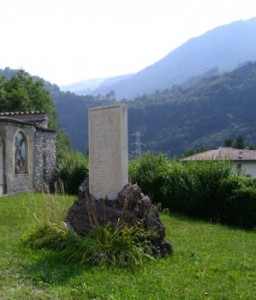A Story of Bravery~The Story of Leopolde and His Companions
The story begins in the valley above Introbio, carved out by the raging Troggio river. Upwards, beyond the mountain tops, lies the Biandino Valley. This is where the resistance was based. This is the ancient road of Bitto, a strategic position that leads into the Troggio Valley. It was here, at dawn, on October 11, 1944, that Guerino Besana was wounded in a trap set by the nazi-facists. He manages to free himself and laboriously starts to make his way back up the mountain to warn his companions of the imminent danger.
Bessana travels this rocky road, determined to warn his companions. At five in the evening it is here not far from the valley that Bessana’s companions find him dying. There is a cave to the side of the road. Carletto Bessano does not want to leave his brother. He drags him into the cave and stays at his side until he dies. As he masks the entrance to the cave, he is surprised by the nazi-facists, is captured, imprisoned and shot the next day.
As we proceed higher up in the valley of Troggia, at the mouth of the Biandino, is this stone and aluminum monument commemorating the resistance fighters. It reads: Company Garibaldi “Rosselli 55”
The Val Biandino opens upwards to the Troggia Valley. For hundreds of years during peaceful times this was the summer place to pasture animals for the people of Introbio.













